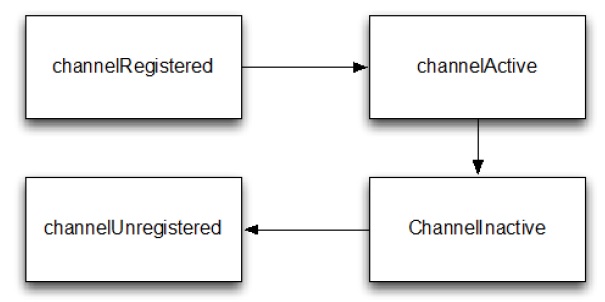- Introduction
- 1. 开始
- 2. 核心功能
- 3. NETTY BY EXAMPLE
- 4. 高级主题
- Published with GitBook
ChannelHandler 家族
在我们深入研究 Channelhandler 内部之前,让我们花几分钟了解下这个领域的 Netty 组件模型的基础。这里提供一个 Channelhandler 及其子类的研究有价值的背景。
Channel 生命周期
Channel 有个简单但强大的状态模型,与 ChannelInboundHandler API 密切相关。下面表格是 Channel 的四个状态
Table 6.1 Channel lifeycle states
| 状态 | 描述 |
|---|---|
| channelUnregistered | channel创建但未注册到一个 EventLoop. |
| channelRegistered | channel 注册到一个 EventLoop. |
| channelActive | channel 的活动的(连接到了它的 remote peer(远程对等方)),现在可以接收和发送数据了 |
| channelInactive | channel 没有连接到 remote peer(远程对等方) |
Channel 的正常的声明周期如下图,当这些状态变化出现,对应的事件将会生成,这样与 ChannelPipeline 中的 ChannelHandler 的交互就能及时响应
Figure 6.1 Channel State Model

ChannelHandler 生命周期
ChannelHandler 定义的声明周期操作如下表,当 ChannelHandler 添加到 ChannelPipeline,或者从 ChannelPipeline 移除后,这些将会调用。每个方法都会带 ChannelHandlerContext 参数
Table 6.2 ChannelHandler lifecycle methods
| 类型 | 描述 |
|---|---|
| handlerAdded | 当 ChannelHandler 添加到 ChannelPipeline 调用 |
| handlerRemoved | 当 ChannelHandler 从 ChannelPipeline 移除时调用 |
| exceptionCaught | 当 ChannelPipeline 执行发生错误时调用 |
ChannelHandler 子接口
Netty 提供2个重要的 ChannelHandler 子接口:
- ChannelInboundHandler - 处理进站数据,并且所有状态都更改
- ChannelOutboundHandler - 处理出站数据,允许拦截各种操作
ChannelHandler 适配器
Netty 提供了一个简单的 ChannelHandler 框架实现,给所有声明方法签名。这个类 ChannelHandlerAdapter 的方法,主要推送事件 到 pipeline 下个 ChannelHandler 直到 pipeline 的结束。这个类 也作为 ChannelInboundHandlerAdapter 和ChannelOutboundHandlerAdapter 的基础。所有三个适配器类的目的是作为自己的实现的起点;您可以扩展它们,覆盖你需要自定义的方法。
ChannelInboundHandler
ChannelInboundHandler 的生命周期方法在下表中,当接收到数据或者与之关联的 Channel 状态改变时调用。之前已经注意到了,这些方法与 Channel 的生命周期接近
Table 6.3 ChannelInboundHandler methods
| 类型 | 描述 |
|---|---|
| channelRegistered | Invoked when a Channel is registered to its EventLoop and is able to handle I/O. |
| channelUnregistered | Invoked when a Channel is deregistered from its EventLoop and cannot handle any I/O. |
| channelActive | Invoked when a Channel is active; the Channel is connected/bound and ready. |
| channelInactive | Invoked when a Channel leaves active state and is no longer connected to its remote peer. |
| channelReadComplete | Invoked when a read operation on the Channel has completed. |
| channelRead | Invoked if data are read from the Channel. |
| channelWritabilityChanged | Invoked when the writability state of the Channel changes. The user can ensure writes are not done too fast (with risk of an OutOfMemoryError) or can resume writes when the Channel becomes writable again.Channel.isWritable() can be used to detect the actual writability of the channel. The threshold for writability can be set via Channel.config().setWriteHighWaterMark() and Channel.config().setWriteLowWaterMark(). |
| userEventTriggered(...) | Invoked when a user calls Channel.fireUserEventTriggered(...) to pass a pojo through the ChannelPipeline. This can be used to pass user specific events through the ChannelPipeline and so allow handling those events. |
注意,ChannelInboundHandler 实现覆盖了 channelRead() 方法处理进来的数据用来响应释放资源。Netty 在 ByteBuf 上使用的资源池,所以当执行释放资源时可以减少内存的消耗。
Listing 6.1 Handler to discard data
@ChannelHandler.Sharable
public class DiscardHandler extends ChannelInboundHandlerAdapter { //1
@Override
public void channelRead(ChannelHandlerContext ctx,
Object msg) {
ReferenceCountUtil.release(msg); //2
}
}
1.扩展 ChannelInboundHandlerAdapter
2.ReferenceCountUtil.release() 来丢弃收到的信息
Netty 用一个 WARN-level 日志条目记录未释放的资源,使其相当简单 的找到违规实例的代码。然而,由于可以手工管理资源可能很繁琐,您可以通过使用 SimpleChannelInboundHandler 简化问题。如下:
Listing 6.2 Handler to discard data
@ChannelHandler.Sharable
public class SimpleDiscardHandler extends SimpleChannelInboundHandler<Object> { //1
@Override
public void channelRead0(ChannelHandlerContext ctx,
Object msg) {
// No need to do anything special //2
}
}
1.扩展 SimpleChannelInboundHandler
2.不需做特别的释放资源的动作
注意 SimpleChannelInboundHandler 会自动释放资源,而无需存储任何信息的引用。
更多详见 “Error! Reference source not found..” 一节
ChannelOutboundHandler
ChannelOutboundHandler 提供了出站操作需要请求的方法。这些方法会被 Channel, ChannelPipeline, 和 ChannelHandlerContext。
ChannelOutboundHandler 另个一个强大的方面是它具有在请求时延迟操作或者事件的能力。比如,你可以延迟刷新操作当你写数据到 remote peer 是暂停的,那么可以在迟些时候将他们继续。
下面显示了 ChannelOutboundHandler 的方法(继承自 ChannelHandler 未列出来)
Table 6.4 ChannelOutboundHandler methods
| 类型 | 描述 |
|---|---|
| bind | Invoked on request to bind the Channel to a local address |
| connect | Invoked on request to connect the Channel to the remote peer |
| disconnect | Invoked on request to disconnect the Channel from the remote peer |
| close | Invoked on request to close the Channel |
| deregister | Invoked on request to deregister the Channel from its EventLoop |
| read | Invoked on request to read more data from the Channel |
| flush | Invoked on request to flush queued data to the remote peer through the Channel |
| write | Invoked on request to write data through the Channel to the remote peer |
几乎所有的方法都将 ChannelPromise 作为参数,必须被通知一次请求应该停止通过 ChannelPipeline 转发。
ChannelPromise vs. ChannelFuture
ChannelPromise 是 特殊的 ChannelFuture,允许你的ChannelPromise 及其 操作 成功或失败。所以任何时候调用例如 Channel.write(...) 一个新的 ChannelPromise 将会创建并且传递通过 ChannelPipeline。写本身将会返回 ChannelFuture, 这样只允许你得到一次操作完成的通知。Netty 本身使用 ChannelPromise 作为返回的 ChannelFuture 的通知,事实上在大多数时候就是 ChannelPromise自身(ChannelPromise 扩展了 ChannelFuture)